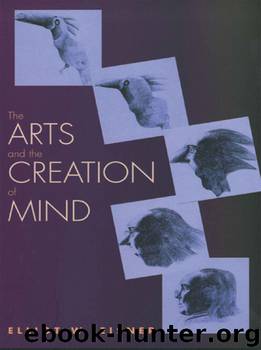The Arts and the Creation of Mind by Elliot W. Eisner

Author:Elliot W. Eisner [Eisner, Elliot W.]
Language: eng
Format: epub
ISBN: 9780300133578
Publisher: Yale University Press
Published: 2002-04-21T04:00:00+00:00
For Davis the bottom of the “U” represents the low level of aesthetic interest in middle childhood, while preschoolers and adolescents have a keen interest in aesthetic matters.
Children may create work whose qualities they themselves may not appreciate or even recognize. A bold sunflower may have the attractiveness of a van Gogh to a sensitive adult, but to a preschool child it may simply be the result of another enjoyable activity with paint or clay. We seldom see preschoolers looking at their own work from a distance in order to do the visual editing that would enhance their work. The paper on which preschool children paint may represent more of an arena for making a gesture that leaves a visual residue than an occasion for creating an image that they intend to have aesthetic properties.
Some of the roles of art education are to enable youngsters to learn how to attend to the qualities they create, to promote through the design of an educative environment an appetite for creating visual images, and to enable them to secure in a developmentally appropriate way the skills that will enable them to work effectively with the material.
In a modest way, nursery school teachers already teach preschoolers technical skills, if only to enable them to learn how to wipe the black paint off their brushes before putting them into white tempera jars. A small bit of technology, but an important one.
Children between four and seven will often emphasize through size relationships in a drawing or painting that are important to them; their emotional attachment to an individual or the significance that something has to them is reflected in the size of the images they make. The feeling and significance of something for children of this age swamp the aspiration to create visual verisimilitude.
Another feature of the artwork of children between four and seven is that they often focus on each entity drawn without paying much attention to the relationships among them. Instead of looking at relationships, they have local visual solutions. Local solutions do not take into account context; the young child wants the cookie now, even though dinner is five minutes away. Objects are drawn as if occupying their own space, largely independent of the visual field they share with other forms. One of the aims of art education is to help children learn to notice the expressive quality of relationships. Through good art teaching, students learn to compose relationships and to rely upon somatic knowledge, the bodily feel of a rightness of fit for making adjustments in what has been composed. The ability to experience such relationships is the result of developed thinking skills. These are skills that even many adults have not developed in the visual arts.
I have been describing the forms of learning that work in the arts promotes. Most of my comments have pertained to either the perception or the creation of visual form—the drawings, the paintings, the sculptures that children and adolescents create. But what matters with respect to learning in the arts is wider than matters of perception and creation, as significant as they are.
Download
This site does not store any files on its server. We only index and link to content provided by other sites. Please contact the content providers to delete copyright contents if any and email us, we'll remove relevant links or contents immediately.
The Art of Coaching Workbook by Elena Aguilar(50965)
Trainspotting by Irvine Welsh(21518)
Twilight of the Idols With the Antichrist and Ecce Homo by Friedrich Nietzsche(18501)
Fangirl by Rainbow Rowell(9095)
Periodization Training for Sports by Tudor Bompa(8168)
Change Your Questions, Change Your Life by Marilee Adams(7633)
This Is How You Lose Her by Junot Diaz(6778)
Asking the Right Questions: A Guide to Critical Thinking by M. Neil Browne & Stuart M. Keeley(5631)
Grit by Angela Duckworth(5512)
Red Sparrow by Jason Matthews(5390)
Paper Towns by Green John(5087)
Room 212 by Kate Stewart(5035)
Ken Follett - World without end by Ken Follett(4643)
Housekeeping by Marilynne Robinson(4334)
The Sports Rules Book by Human Kinetics(4288)
Double Down (Diary of a Wimpy Kid Book 11) by Jeff Kinney(4204)
Papillon (English) by Henri Charrière(4195)
The Motorcycle Diaries by Ernesto Che Guevara(4009)
Exercise Technique Manual for Resistance Training by National Strength & Conditioning Association(3955)
